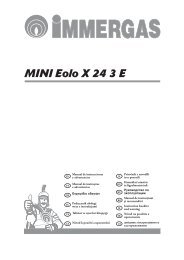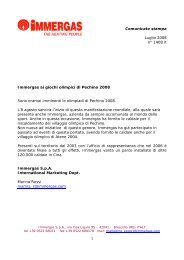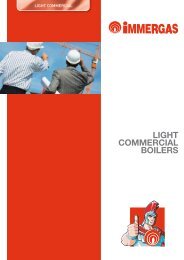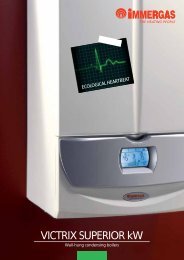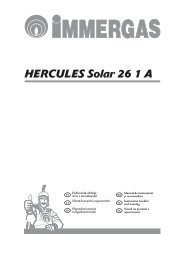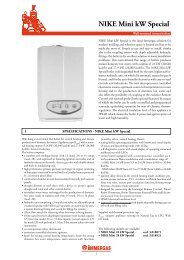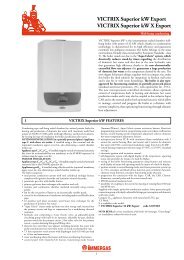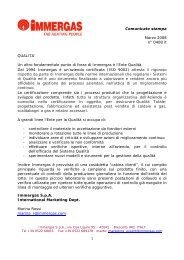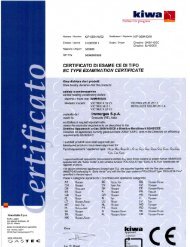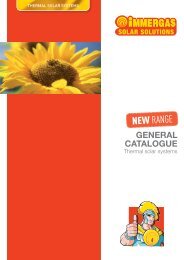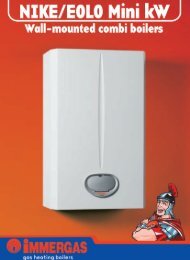MINI Nike 24 3 E - Immergas
MINI Nike 24 3 E - Immergas
MINI Nike 24 3 E - Immergas
Create successful ePaper yourself
Turn your PDF publications into a flip-book with our unique Google optimized e-Paper software.
ES<br />
PL<br />
TR<br />
CZ<br />
SI<br />
HU<br />
RU<br />
RO<br />
IE<br />
SK<br />
UA<br />
146<br />
1.5 EXTERNAL PROBE (OPTIONAL).<br />
The boiler is prepared for the application of the<br />
external probe (Fig. 1-7), which is available as<br />
an optional kit.<br />
The probe can be connected directly to the boiler<br />
electrical system and allows the max. system<br />
flow temperature to be automatically decreased<br />
when the external temperature increases, in<br />
order to adjust the heat supplied to the system<br />
according to the change in external temperature.<br />
The external probe always acts when connected<br />
independently from the presence or type of room<br />
thermostat used. The correlation between system<br />
flow temperature and external temperature is determined<br />
by the position of the selector switch on<br />
the boiler control panel according to the curves<br />
shown in the diagram (Fig. 1-8). The electric connection<br />
of the external probe must be made on<br />
clamps 38 and 39 on the boiler P.C.B. (Fig. 3-2).<br />
1.6 VENTILATION OF THE ROOMS.<br />
In the room in which the boiler is installed it is<br />
necessary that at least as much air flows as that<br />
requested for by normal combustion of the gas<br />
and ventilation of the room. Natural air flow must<br />
take place directly through:<br />
- permanent openings in the walls of the room<br />
to ventilate that lead towards the outside;<br />
- condotti di ventilazione, singoli oppure collettivi<br />
ramificati.<br />
The air used for ventilation must be withdrawn<br />
directly from outside, in an area away from<br />
sources of pollution. Natural air flow is also<br />
allowed indirectly by air intake from adjoining<br />
rooms. For further information relative to<br />
ventilation of the rooms follow that envisioned<br />
in the regulation.<br />
Evacuation of foul air. In the rooms where the<br />
gas appliances are installed it may also be necessary,<br />
as well as the intake of combustion agent air,<br />
to evacuate foul air, with consequent intake of a<br />
further equal amount of clean air. This must be<br />
realised respecting the provisions of the technical<br />
regulations in force.<br />
1.7 FLUE DUCTS.<br />
The gas appliances with attachment for the flues<br />
discharge pipe must have direct connection to<br />
chimneys or safely efficient flues.<br />
Only if these are missing can the combustion<br />
products be discharged directly to the outside, as<br />
long as the standard regulations for the flue terminal<br />
are respected as well as the existing laws.<br />
Connection to chimneys or flues. The connection<br />
of the appliances to a chimney or flue takes<br />
place by means of flue ducts.<br />
31<br />
45<br />
58<br />
In the case of connection to pre-existing flues, these<br />
must be perfectly clean as the slag, if present, on<br />
detachment from the walls during functioning,<br />
could obstruct the passage of flue gass, causing<br />
extremely dangerous situations for the user.<br />
The flue ducts must be connected to the chimney<br />
or flue in the same room in which the appliance<br />
is installed or, at most, in the adjoining room<br />
and must comply with the requisites of this<br />
regulation.<br />
1.8 FLUES/CHIMNEYS.<br />
For the appliances with natural draught individual<br />
chimneys and branched flues can be used.<br />
Individual chimneys. The internal dimensions<br />
of some types of individual chimneys are contained<br />
within the prospects of the regulation. If<br />
the effective system data do not fall within the<br />
conditions of applicability or the table limits, the<br />
size of the chimney must be calculated according<br />
to the regulation.<br />
Branched flues. In buildings with lots of floors,<br />
branched flues can be used for the natural<br />
draught evacuation of combustion products<br />
(c.c.r.). New CCR must be designed following the<br />
calculation method and regulation standards.<br />
Chimney caps. The cap is a device positioned<br />
crowning an individual chimney or branched<br />
flue. This device eases the dispersion of combustion<br />
products, even in adverse weather conditions,<br />
and prevents the deposit of foreign<br />
bodies.<br />
This must satisfy the requisites of the regulation.<br />
In order to prevent the formation of counterpressures<br />
that impede the discharge of combustion<br />
products into the atmosphere, the outlet<br />
height corresponding to the top of the chimney/<br />
flue, independently of any caps, must be over the<br />
“backflow area”. It is therefore necessary to use<br />
the minimum heights indicated in the figures<br />
stated in the regulation, depending on the slope<br />
of the roof.<br />
Direct exhaust to the outside. The natural<br />
draught appliances to be connected to a chimney<br />
or a flue can discharge the combustion products<br />
directly to the outside, through a pipe passing<br />
through the perimeter walls of the building. In<br />
this case discharge takes place through an exhaust<br />
flue, which is connected to a draught terminal<br />
at the outside.<br />
Exhaust flue. The exhaust flue must be in compliance<br />
with the same requisites listed for the<br />
flue ducts, with further provisions stated in the<br />
regulation in force.<br />
Positioning the draught terminals. The draught<br />
terminals must:<br />
- be installed on external perimeter walls of the<br />
building;<br />
- be positioned according to the minimum<br />
distances specified in current technical standards.<br />
Flue exhaust of forced draught appliances<br />
in closed open-top environments. In spaces<br />
closed on all sides with open tops (ventilation<br />
pits, courtyards etc.), direct flue gas exhaust is<br />
allowed for natural or forced draught gas appliances<br />
with a heating power range from 4 to<br />
35 kW, provided the conditions as per the current<br />
technical standards are respected.<br />
Important: it is prohibited to put the flues<br />
exhaust control device out of order voluntarily.<br />
Every piece of this device must be replaced using<br />
original spare parts if they have deteriorated. In<br />
the case of repeated interventions of the flues<br />
exhaust control device, check the flues exhaust<br />
flue and the ventilation of the room in which the<br />
boiler is located.<br />
1.9 SYSTEM FILLING.<br />
Once the boiler is connected, fill the system via<br />
the filling valve (Fig. 2-2). Filling is performed<br />
at low speed to ensure release of air bubbles in<br />
the water via the boiler and heating system vents.<br />
The boiler has a built-in automatic venting valve<br />
on the circulator. Open the radiator vent valves.<br />
Close radiator vent valves only when water escapes<br />
from them.<br />
Close the filling valve when the boiler manometer<br />
indicates approx. 1.2 bar.<br />
N.B.: during these operations start up the circulation<br />
pump at intervals, acting on the main<br />
switch positioned on the control panel. Vent the<br />
circulation pump by loosening the front cap and<br />
keeping the motor running.<br />
Tighten the cap after the operation.<br />
Position of the central heating temperature user adjustment<br />
central heating temperature<br />
Fig. 1-7 Fig. 1-8



